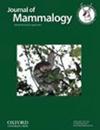Genetic footprints of Quaternary climatic fluctuations on the endangered Tuco-tuco-das-dunas (Ctenomys flamarioni)
IF 1.5
3区 生物学
Q2 ZOOLOGY
引用次数: 0
Abstract
The biogeographic history of a species results from responses to past and current processes, and understanding those responses at both temporal scales is essential. We explored phylogeographic and current genetic variation structure in Ctenomys flamarioni—a subterranean rodent that inhabits a small region of the coastal plain of Brazil—and contrasted the roles of “present-day niche suitability” versus “historical climate stability” to understand current and past intraspecific genetic diversity. We used both mitochondrial DNA sequences (concatenated Cytb and D-loop, n = 78) and nuclear DNA (9 microsatellites loci, n = 154) molecular markers for individuals across the entire distribution of the species. We used phylogeographic trees, Bayesian clustering, and haplotype networks to explore genetic variation and diversity. We correlated genetic diversity with measures of current niche suitability and potential areas of Late Quaternary paleostability. Phylogeographic patterns confirmed low levels of genetic diversity structured at different hierarchical levels. We also found a weak but significant pattern of isolation by distance, indicating that geographical distance partially modulates genetic differences among populations. We also observed a positive correlation between genetic diversity and climate paleostability for microsatellites at local and regional scales. However, we found no significant association between genetic diversity and niche suitability for microsatellites at local or regional scales. We observed several signatures of bottleneck and population expansion at different geographic scales. Our results suggest that Quaternary climatic fluctuations—acting together with habitat suitability and other contemporary factors—played a fundamental role in elucidating the evolutionary history of the species—including patterns of historical dispersal, and current patterns of habitat occupation and genetic structure. In addition, based on our molecular and environmental data sets from the across the range of the species and considering the restricted endemism of C. flamarioni, we emphasize the urgency of conservation actions to protect this endangered species.第四纪气候波动在濒危图科-图科-达斯-杜纳斯(Ctenomys flamarioni)身上留下的遗传足迹
一个物种的生物地理历史源于对过去和当前过程的反应,了解这两个时间尺度上的反应至关重要。我们探索了 Ctenomys flamarioni- 一种栖息于巴西沿海平原一小块区域的地下啮齿动物的系统地理学和当前遗传变异结构,并对比了 "当前生态位适宜性 "和 "历史气候稳定性 "的作用,以了解当前和过去的种内遗传多样性。我们使用线粒体 DNA 序列(Cytb 和 D-loop 连接序列,n = 78)和核 DNA(9 个微卫星位点,n = 154)分子标记来研究该物种整个分布区的个体。我们使用系统地理树、贝叶斯聚类和单体型网络来探索遗传变异和多样性。我们将遗传多样性与当前生态位适宜性和第四纪晚期古稳定性的潜在区域相关联。系统地理学模式证实了不同层次结构的遗传多样性水平较低。我们还发现了一种微弱但显著的距离隔离模式,表明地理距离部分地调节了种群间的遗传差异。我们还观察到,在地方和区域尺度上,微卫星的遗传多样性与气候古稳定性之间存在正相关。然而,我们发现在地方或区域尺度上,微卫星的遗传多样性与生态位适宜性之间没有明显的关联。我们在不同的地理尺度上观察到了几种瓶颈和种群扩张的迹象。我们的研究结果表明,第四纪的气候波动与栖息地适宜性和其他当代因素共同作用,在阐明该物种的进化史(包括历史上的扩散模式以及当前的栖息地占用模式和遗传结构)方面发挥了重要作用。此外,基于我们从该物种分布区收集到的分子和环境数据集,并考虑到 C. flamarioni 的地方特有性,我们强调了保护这一濒危物种的紧迫性。
本文章由计算机程序翻译,如有差异,请以英文原文为准。
求助全文
约1分钟内获得全文
求助全文
来源期刊

Journal of Mammalogy
生物-动物学
CiteScore
3.30
自引率
5.90%
发文量
106
审稿时长
4-8 weeks
期刊介绍:
Papers are published on mammalian behavior, conservation, ecology, genetics, morphology, physiology, and taxonomy.
 求助内容:
求助内容: 应助结果提醒方式:
应助结果提醒方式:


